Visitor Attraction Management: Strategies and Impacts on UK Tourism
VerifiedAdded on 2024/05/21
|26
|7182
|154
Report
AI Summary
This report provides an in-depth analysis of visitor attraction management within the UK tourism industry. It discusses overlapping and particular types of visitor attractions, evaluates visitor motivations and needs, and assesses the impacts of tourism on visitor attractions. The report also explores different management strategies for visitors and evaluates the sustainability of current management techniques. The study highlights the importance of strategic management in enhancing tourism, increasing job opportunities, and contributing to the UK's GDP. It also addresses potential negative impacts of over-tourism and emphasizes the need for controlled and sustainable tourism practices. The report concludes by summarizing key findings and providing recommendations for effective visitor attraction management in the UK.
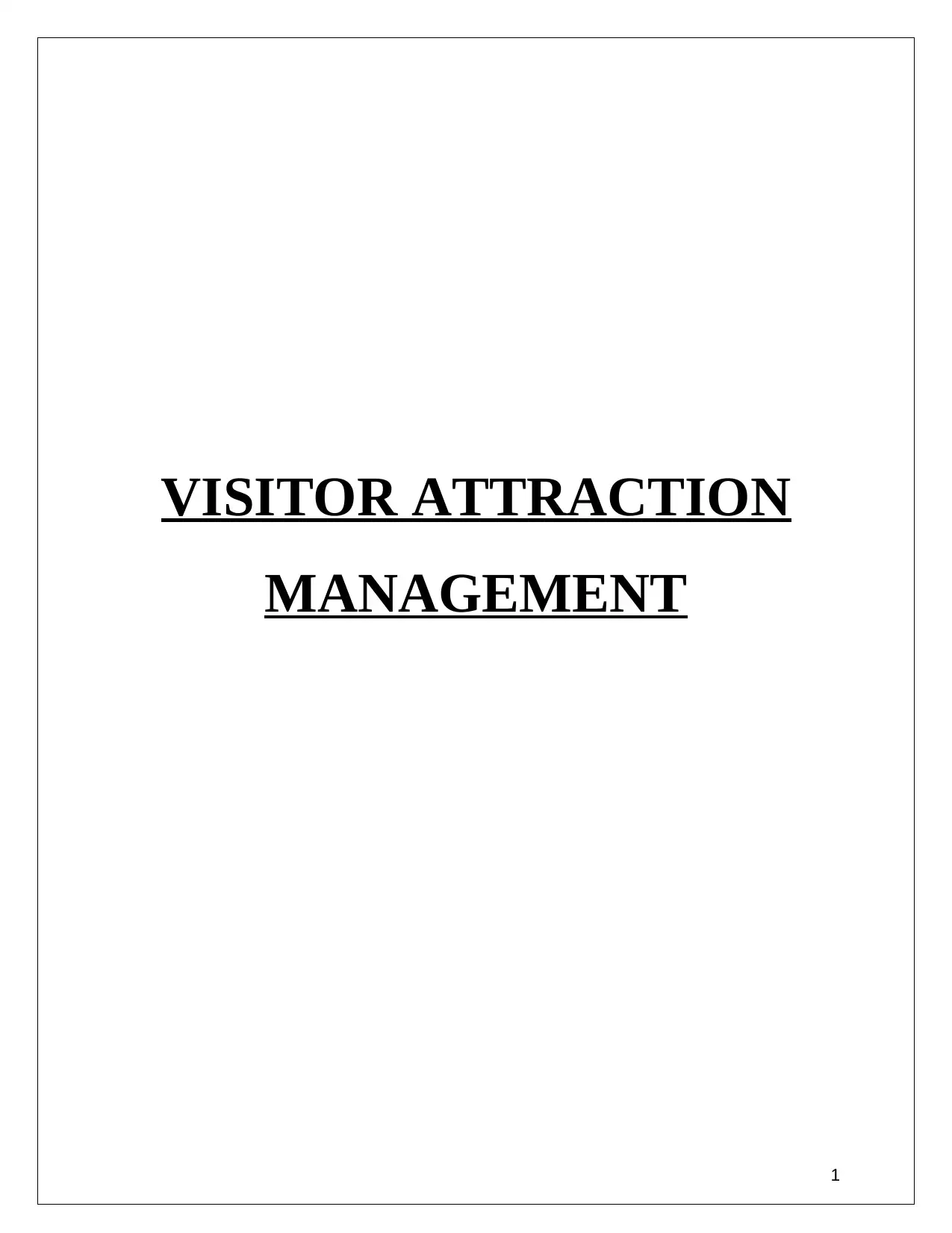
VISITOR ATTRACTION
MANAGEMENT
1
MANAGEMENT
1
Paraphrase This Document
Need a fresh take? Get an instant paraphrase of this document with our AI Paraphraser
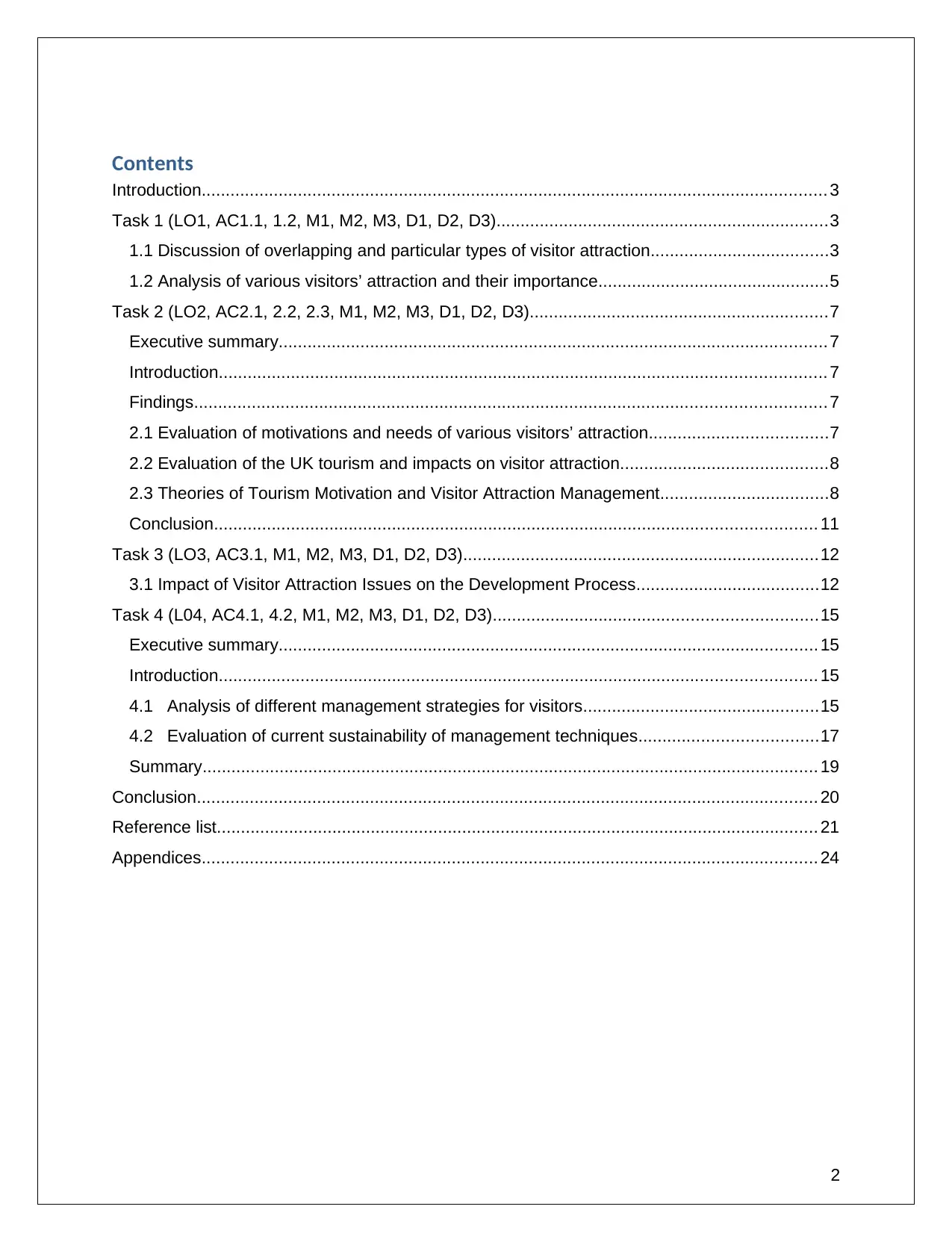
Contents
Introduction.................................................................................................................................. 3
Task 1 (LO1, AC1.1, 1.2, M1, M2, M3, D1, D2, D3).....................................................................3
1.1 Discussion of overlapping and particular types of visitor attraction.....................................3
1.2 Analysis of various visitors’ attraction and their importance................................................5
Task 2 (LO2, AC2.1, 2.2, 2.3, M1, M2, M3, D1, D2, D3)..............................................................7
Executive summary.................................................................................................................. 7
Introduction.............................................................................................................................. 7
Findings................................................................................................................................... 7
2.1 Evaluation of motivations and needs of various visitors’ attraction.....................................7
2.2 Evaluation of the UK tourism and impacts on visitor attraction...........................................8
2.3 Theories of Tourism Motivation and Visitor Attraction Management...................................8
Conclusion............................................................................................................................. 11
Task 3 (LO3, AC3.1, M1, M2, M3, D1, D2, D3)..........................................................................12
3.1 Impact of Visitor Attraction Issues on the Development Process......................................12
Task 4 (L04, AC4.1, 4.2, M1, M2, M3, D1, D2, D3)...................................................................15
Executive summary................................................................................................................ 15
Introduction............................................................................................................................ 15
4.1 Analysis of different management strategies for visitors.................................................15
4.2 Evaluation of current sustainability of management techniques.....................................17
Summary................................................................................................................................ 19
Conclusion................................................................................................................................. 20
Reference list............................................................................................................................. 21
Appendices................................................................................................................................ 24
2
Introduction.................................................................................................................................. 3
Task 1 (LO1, AC1.1, 1.2, M1, M2, M3, D1, D2, D3).....................................................................3
1.1 Discussion of overlapping and particular types of visitor attraction.....................................3
1.2 Analysis of various visitors’ attraction and their importance................................................5
Task 2 (LO2, AC2.1, 2.2, 2.3, M1, M2, M3, D1, D2, D3)..............................................................7
Executive summary.................................................................................................................. 7
Introduction.............................................................................................................................. 7
Findings................................................................................................................................... 7
2.1 Evaluation of motivations and needs of various visitors’ attraction.....................................7
2.2 Evaluation of the UK tourism and impacts on visitor attraction...........................................8
2.3 Theories of Tourism Motivation and Visitor Attraction Management...................................8
Conclusion............................................................................................................................. 11
Task 3 (LO3, AC3.1, M1, M2, M3, D1, D2, D3)..........................................................................12
3.1 Impact of Visitor Attraction Issues on the Development Process......................................12
Task 4 (L04, AC4.1, 4.2, M1, M2, M3, D1, D2, D3)...................................................................15
Executive summary................................................................................................................ 15
Introduction............................................................................................................................ 15
4.1 Analysis of different management strategies for visitors.................................................15
4.2 Evaluation of current sustainability of management techniques.....................................17
Summary................................................................................................................................ 19
Conclusion................................................................................................................................. 20
Reference list............................................................................................................................. 21
Appendices................................................................................................................................ 24
2
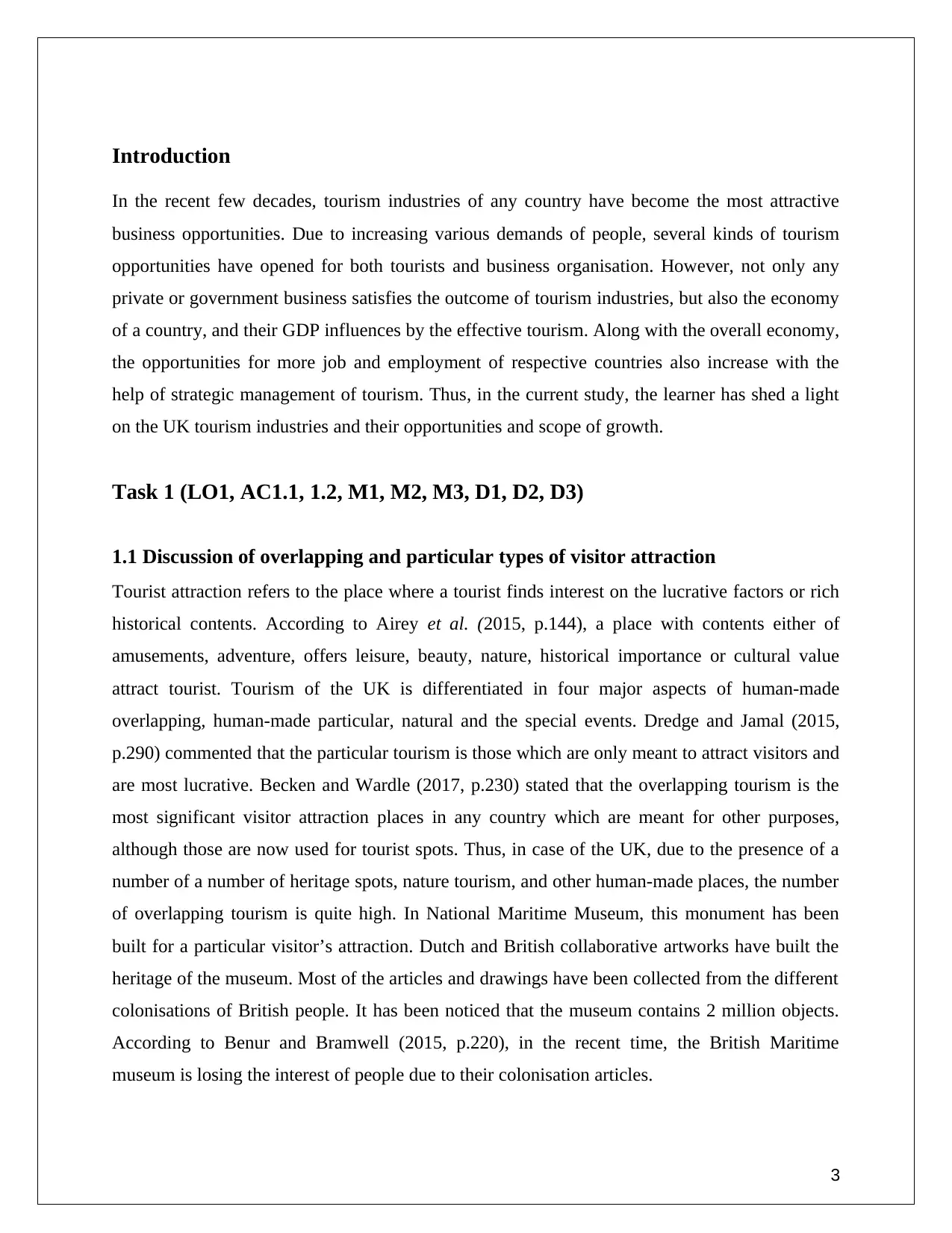
Introduction
In the recent few decades, tourism industries of any country have become the most attractive
business opportunities. Due to increasing various demands of people, several kinds of tourism
opportunities have opened for both tourists and business organisation. However, not only any
private or government business satisfies the outcome of tourism industries, but also the economy
of a country, and their GDP influences by the effective tourism. Along with the overall economy,
the opportunities for more job and employment of respective countries also increase with the
help of strategic management of tourism. Thus, in the current study, the learner has shed a light
on the UK tourism industries and their opportunities and scope of growth.
Task 1 (LO1, AC1.1, 1.2, M1, M2, M3, D1, D2, D3)
1.1 Discussion of overlapping and particular types of visitor attraction
Tourist attraction refers to the place where a tourist finds interest on the lucrative factors or rich
historical contents. According to Airey et al. (2015, p.144), a place with contents either of
amusements, adventure, offers leisure, beauty, nature, historical importance or cultural value
attract tourist. Tourism of the UK is differentiated in four major aspects of human-made
overlapping, human-made particular, natural and the special events. Dredge and Jamal (2015,
p.290) commented that the particular tourism is those which are only meant to attract visitors and
are most lucrative. Becken and Wardle (2017, p.230) stated that the overlapping tourism is the
most significant visitor attraction places in any country which are meant for other purposes,
although those are now used for tourist spots. Thus, in case of the UK, due to the presence of a
number of a number of heritage spots, nature tourism, and other human-made places, the number
of overlapping tourism is quite high. In National Maritime Museum, this monument has been
built for a particular visitor’s attraction. Dutch and British collaborative artworks have built the
heritage of the museum. Most of the articles and drawings have been collected from the different
colonisations of British people. It has been noticed that the museum contains 2 million objects.
According to Benur and Bramwell (2015, p.220), in the recent time, the British Maritime
museum is losing the interest of people due to their colonisation articles.
3
In the recent few decades, tourism industries of any country have become the most attractive
business opportunities. Due to increasing various demands of people, several kinds of tourism
opportunities have opened for both tourists and business organisation. However, not only any
private or government business satisfies the outcome of tourism industries, but also the economy
of a country, and their GDP influences by the effective tourism. Along with the overall economy,
the opportunities for more job and employment of respective countries also increase with the
help of strategic management of tourism. Thus, in the current study, the learner has shed a light
on the UK tourism industries and their opportunities and scope of growth.
Task 1 (LO1, AC1.1, 1.2, M1, M2, M3, D1, D2, D3)
1.1 Discussion of overlapping and particular types of visitor attraction
Tourist attraction refers to the place where a tourist finds interest on the lucrative factors or rich
historical contents. According to Airey et al. (2015, p.144), a place with contents either of
amusements, adventure, offers leisure, beauty, nature, historical importance or cultural value
attract tourist. Tourism of the UK is differentiated in four major aspects of human-made
overlapping, human-made particular, natural and the special events. Dredge and Jamal (2015,
p.290) commented that the particular tourism is those which are only meant to attract visitors and
are most lucrative. Becken and Wardle (2017, p.230) stated that the overlapping tourism is the
most significant visitor attraction places in any country which are meant for other purposes,
although those are now used for tourist spots. Thus, in case of the UK, due to the presence of a
number of a number of heritage spots, nature tourism, and other human-made places, the number
of overlapping tourism is quite high. In National Maritime Museum, this monument has been
built for a particular visitor’s attraction. Dutch and British collaborative artworks have built the
heritage of the museum. Most of the articles and drawings have been collected from the different
colonisations of British people. It has been noticed that the museum contains 2 million objects.
According to Benur and Bramwell (2015, p.220), in the recent time, the British Maritime
museum is losing the interest of people due to their colonisation articles.
3
⊘ This is a preview!⊘
Do you want full access?
Subscribe today to unlock all pages.

Trusted by 1+ million students worldwide
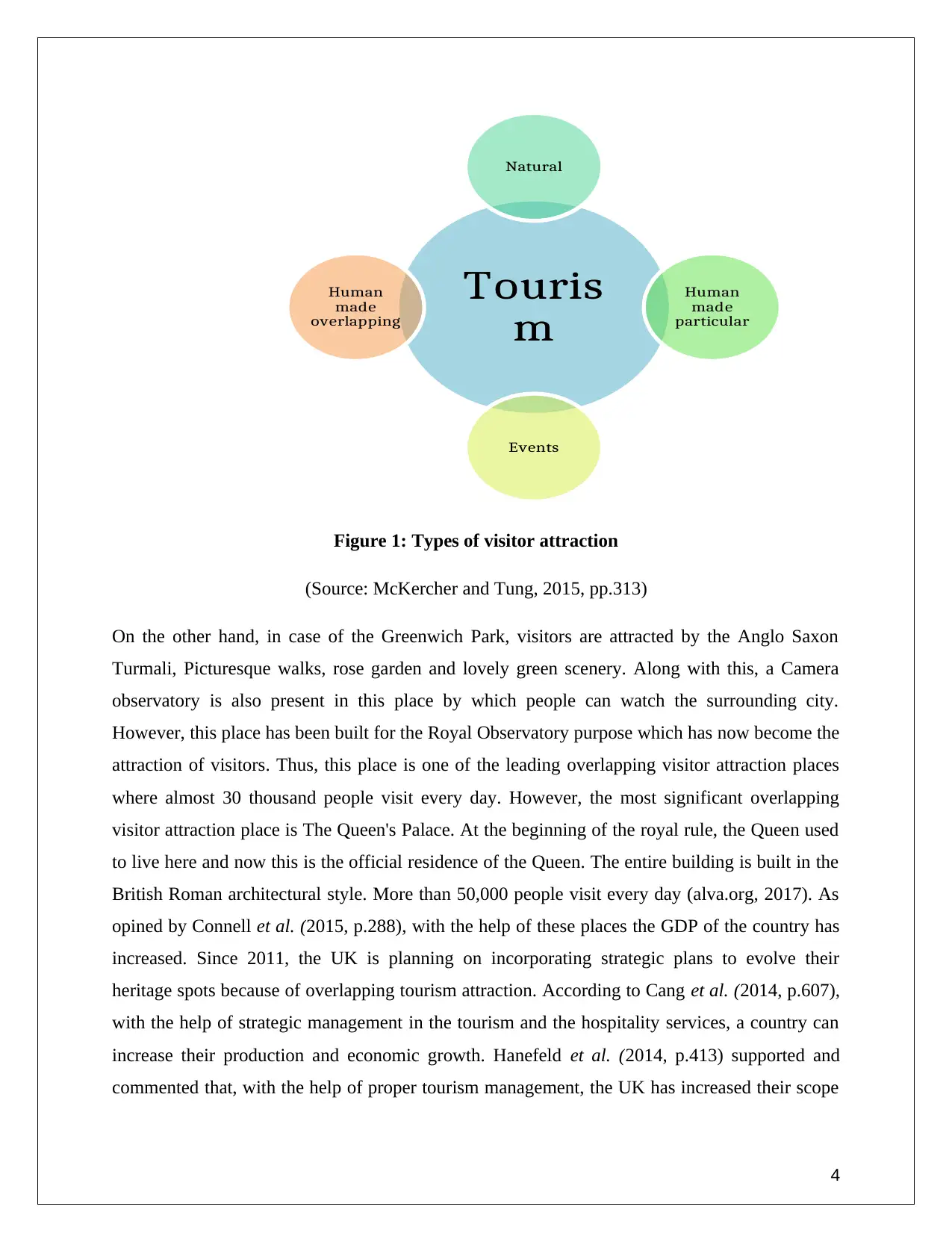
Figure 1: Types of visitor attraction
(Source: McKercher and Tung, 2015, pp.313)
On the other hand, in case of the Greenwich Park, visitors are attracted by the Anglo Saxon
Turmali, Picturesque walks, rose garden and lovely green scenery. Along with this, a Camera
observatory is also present in this place by which people can watch the surrounding city.
However, this place has been built for the Royal Observatory purpose which has now become the
attraction of visitors. Thus, this place is one of the leading overlapping visitor attraction places
where almost 30 thousand people visit every day. However, the most significant overlapping
visitor attraction place is The Queen's Palace. At the beginning of the royal rule, the Queen used
to live here and now this is the official residence of the Queen. The entire building is built in the
British Roman architectural style. More than 50,000 people visit every day (alva.org, 2017). As
opined by Connell et al. (2015, p.288), with the help of these places the GDP of the country has
increased. Since 2011, the UK is planning on incorporating strategic plans to evolve their
heritage spots because of overlapping tourism attraction. According to Cang et al. (2014, p.607),
with the help of strategic management in the tourism and the hospitality services, a country can
increase their production and economic growth. Hanefeld et al. (2014, p.413) supported and
commented that, with the help of proper tourism management, the UK has increased their scope
4
Touris
m
Natural
Human
made
particular
Events
Human
made
overlapping
(Source: McKercher and Tung, 2015, pp.313)
On the other hand, in case of the Greenwich Park, visitors are attracted by the Anglo Saxon
Turmali, Picturesque walks, rose garden and lovely green scenery. Along with this, a Camera
observatory is also present in this place by which people can watch the surrounding city.
However, this place has been built for the Royal Observatory purpose which has now become the
attraction of visitors. Thus, this place is one of the leading overlapping visitor attraction places
where almost 30 thousand people visit every day. However, the most significant overlapping
visitor attraction place is The Queen's Palace. At the beginning of the royal rule, the Queen used
to live here and now this is the official residence of the Queen. The entire building is built in the
British Roman architectural style. More than 50,000 people visit every day (alva.org, 2017). As
opined by Connell et al. (2015, p.288), with the help of these places the GDP of the country has
increased. Since 2011, the UK is planning on incorporating strategic plans to evolve their
heritage spots because of overlapping tourism attraction. According to Cang et al. (2014, p.607),
with the help of strategic management in the tourism and the hospitality services, a country can
increase their production and economic growth. Hanefeld et al. (2014, p.413) supported and
commented that, with the help of proper tourism management, the UK has increased their scope
4
Touris
m
Natural
Human
made
particular
Events
Human
made
overlapping
Paraphrase This Document
Need a fresh take? Get an instant paraphrase of this document with our AI Paraphraser
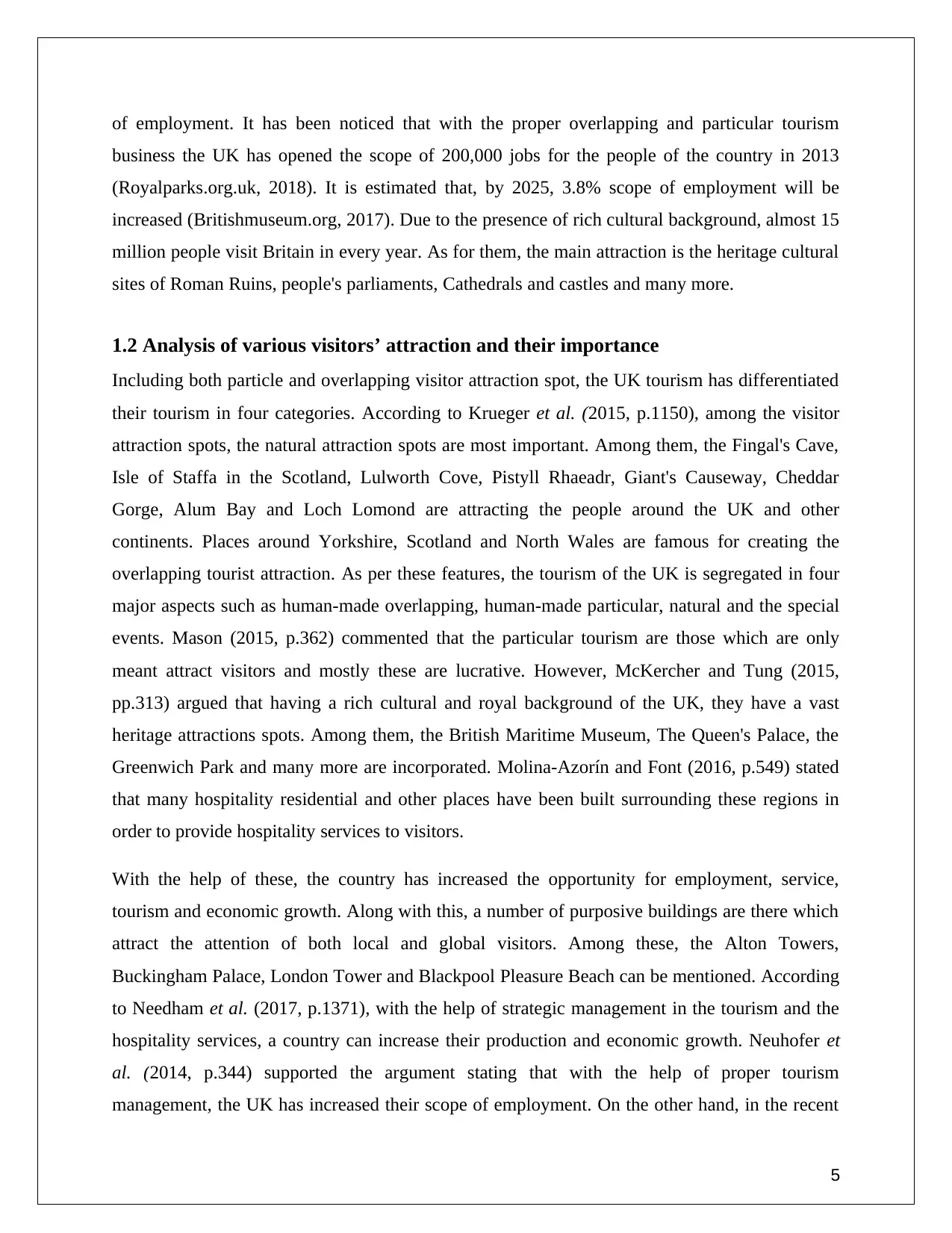
of employment. It has been noticed that with the proper overlapping and particular tourism
business the UK has opened the scope of 200,000 jobs for the people of the country in 2013
(Royalparks.org.uk, 2018). It is estimated that, by 2025, 3.8% scope of employment will be
increased (Britishmuseum.org, 2017). Due to the presence of rich cultural background, almost 15
million people visit Britain in every year. As for them, the main attraction is the heritage cultural
sites of Roman Ruins, people's parliaments, Cathedrals and castles and many more.
1.2 Analysis of various visitors’ attraction and their importance
Including both particle and overlapping visitor attraction spot, the UK tourism has differentiated
their tourism in four categories. According to Krueger et al. (2015, p.1150), among the visitor
attraction spots, the natural attraction spots are most important. Among them, the Fingal's Cave,
Isle of Staffa in the Scotland, Lulworth Cove, Pistyll Rhaeadr, Giant's Causeway, Cheddar
Gorge, Alum Bay and Loch Lomond are attracting the people around the UK and other
continents. Places around Yorkshire, Scotland and North Wales are famous for creating the
overlapping tourist attraction. As per these features, the tourism of the UK is segregated in four
major aspects such as human-made overlapping, human-made particular, natural and the special
events. Mason (2015, p.362) commented that the particular tourism are those which are only
meant attract visitors and mostly these are lucrative. However, McKercher and Tung (2015,
pp.313) argued that having a rich cultural and royal background of the UK, they have a vast
heritage attractions spots. Among them, the British Maritime Museum, The Queen's Palace, the
Greenwich Park and many more are incorporated. Molina-Azorín and Font (2016, p.549) stated
that many hospitality residential and other places have been built surrounding these regions in
order to provide hospitality services to visitors.
With the help of these, the country has increased the opportunity for employment, service,
tourism and economic growth. Along with this, a number of purposive buildings are there which
attract the attention of both local and global visitors. Among these, the Alton Towers,
Buckingham Palace, London Tower and Blackpool Pleasure Beach can be mentioned. According
to Needham et al. (2017, p.1371), with the help of strategic management in the tourism and the
hospitality services, a country can increase their production and economic growth. Neuhofer et
al. (2014, p.344) supported the argument stating that with the help of proper tourism
management, the UK has increased their scope of employment. On the other hand, in the recent
5
business the UK has opened the scope of 200,000 jobs for the people of the country in 2013
(Royalparks.org.uk, 2018). It is estimated that, by 2025, 3.8% scope of employment will be
increased (Britishmuseum.org, 2017). Due to the presence of rich cultural background, almost 15
million people visit Britain in every year. As for them, the main attraction is the heritage cultural
sites of Roman Ruins, people's parliaments, Cathedrals and castles and many more.
1.2 Analysis of various visitors’ attraction and their importance
Including both particle and overlapping visitor attraction spot, the UK tourism has differentiated
their tourism in four categories. According to Krueger et al. (2015, p.1150), among the visitor
attraction spots, the natural attraction spots are most important. Among them, the Fingal's Cave,
Isle of Staffa in the Scotland, Lulworth Cove, Pistyll Rhaeadr, Giant's Causeway, Cheddar
Gorge, Alum Bay and Loch Lomond are attracting the people around the UK and other
continents. Places around Yorkshire, Scotland and North Wales are famous for creating the
overlapping tourist attraction. As per these features, the tourism of the UK is segregated in four
major aspects such as human-made overlapping, human-made particular, natural and the special
events. Mason (2015, p.362) commented that the particular tourism are those which are only
meant attract visitors and mostly these are lucrative. However, McKercher and Tung (2015,
pp.313) argued that having a rich cultural and royal background of the UK, they have a vast
heritage attractions spots. Among them, the British Maritime Museum, The Queen's Palace, the
Greenwich Park and many more are incorporated. Molina-Azorín and Font (2016, p.549) stated
that many hospitality residential and other places have been built surrounding these regions in
order to provide hospitality services to visitors.
With the help of these, the country has increased the opportunity for employment, service,
tourism and economic growth. Along with this, a number of purposive buildings are there which
attract the attention of both local and global visitors. Among these, the Alton Towers,
Buckingham Palace, London Tower and Blackpool Pleasure Beach can be mentioned. According
to Needham et al. (2017, p.1371), with the help of strategic management in the tourism and the
hospitality services, a country can increase their production and economic growth. Neuhofer et
al. (2014, p.344) supported the argument stating that with the help of proper tourism
management, the UK has increased their scope of employment. On the other hand, in the recent
5
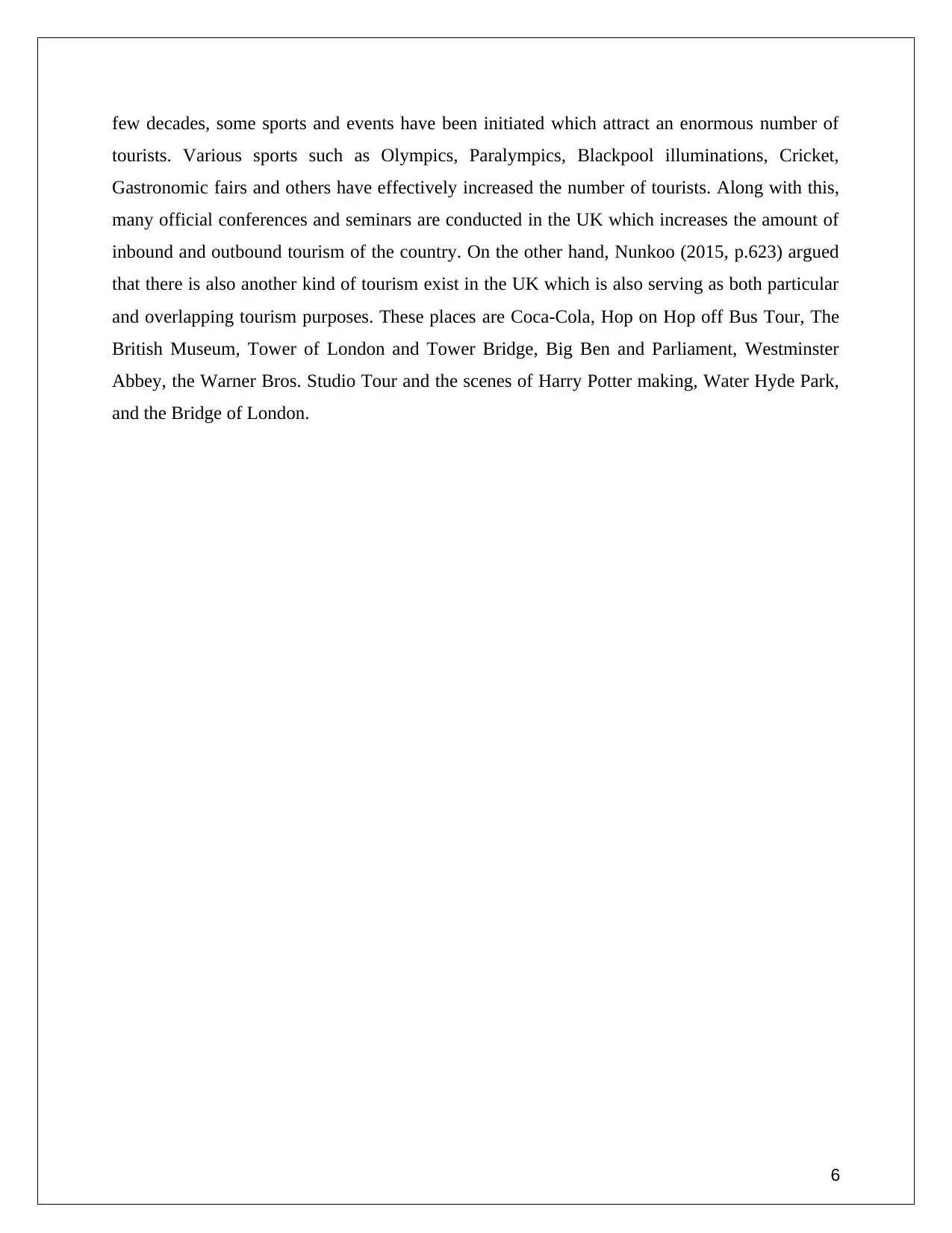
few decades, some sports and events have been initiated which attract an enormous number of
tourists. Various sports such as Olympics, Paralympics, Blackpool illuminations, Cricket,
Gastronomic fairs and others have effectively increased the number of tourists. Along with this,
many official conferences and seminars are conducted in the UK which increases the amount of
inbound and outbound tourism of the country. On the other hand, Nunkoo (2015, p.623) argued
that there is also another kind of tourism exist in the UK which is also serving as both particular
and overlapping tourism purposes. These places are Coca-Cola, Hop on Hop off Bus Tour, The
British Museum, Tower of London and Tower Bridge, Big Ben and Parliament, Westminster
Abbey, the Warner Bros. Studio Tour and the scenes of Harry Potter making, Water Hyde Park,
and the Bridge of London.
6
tourists. Various sports such as Olympics, Paralympics, Blackpool illuminations, Cricket,
Gastronomic fairs and others have effectively increased the number of tourists. Along with this,
many official conferences and seminars are conducted in the UK which increases the amount of
inbound and outbound tourism of the country. On the other hand, Nunkoo (2015, p.623) argued
that there is also another kind of tourism exist in the UK which is also serving as both particular
and overlapping tourism purposes. These places are Coca-Cola, Hop on Hop off Bus Tour, The
British Museum, Tower of London and Tower Bridge, Big Ben and Parliament, Westminster
Abbey, the Warner Bros. Studio Tour and the scenes of Harry Potter making, Water Hyde Park,
and the Bridge of London.
6
⊘ This is a preview!⊘
Do you want full access?
Subscribe today to unlock all pages.

Trusted by 1+ million students worldwide
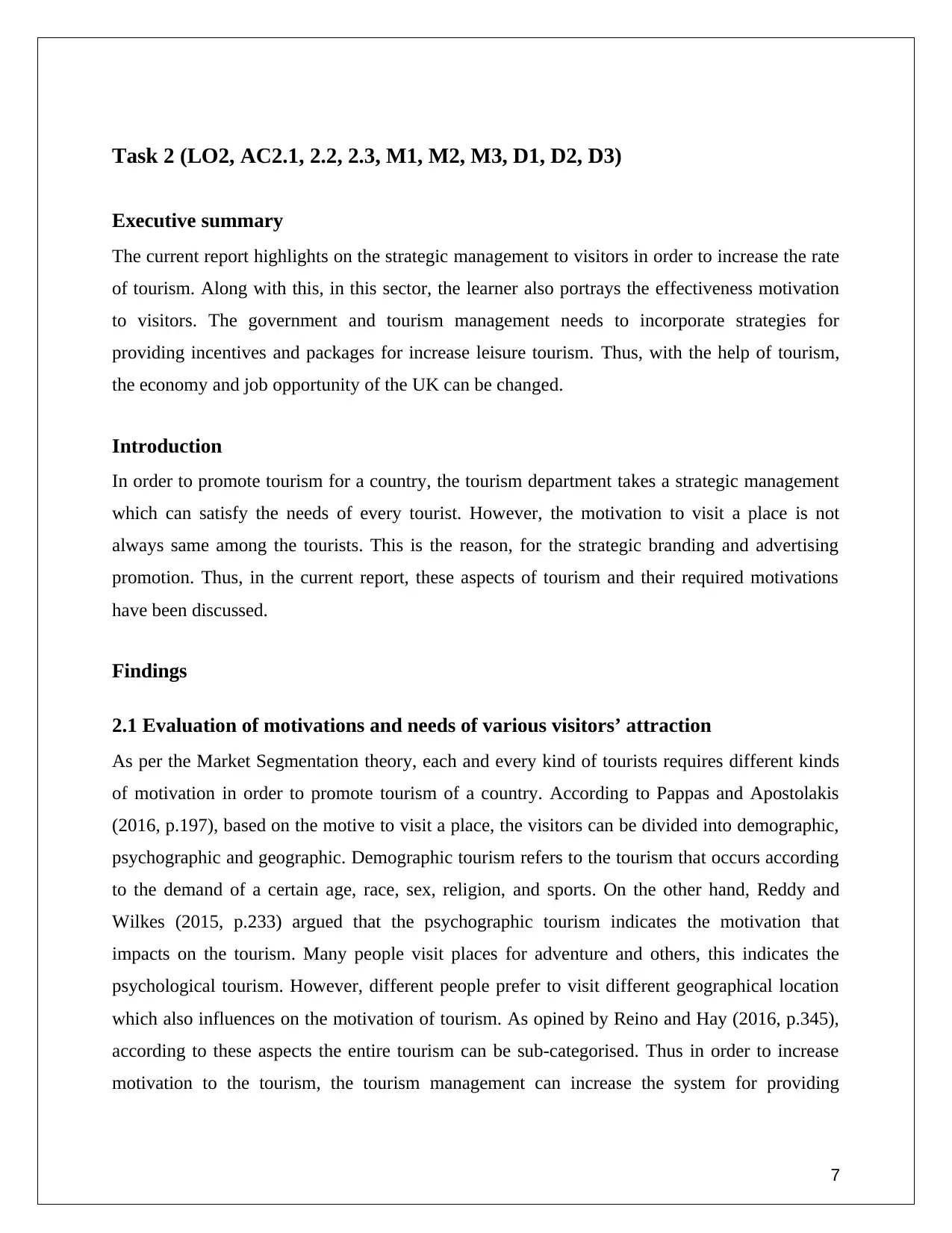
Task 2 (LO2, AC2.1, 2.2, 2.3, M1, M2, M3, D1, D2, D3)
Executive summary
The current report highlights on the strategic management to visitors in order to increase the rate
of tourism. Along with this, in this sector, the learner also portrays the effectiveness motivation
to visitors. The government and tourism management needs to incorporate strategies for
providing incentives and packages for increase leisure tourism. Thus, with the help of tourism,
the economy and job opportunity of the UK can be changed.
Introduction
In order to promote tourism for a country, the tourism department takes a strategic management
which can satisfy the needs of every tourist. However, the motivation to visit a place is not
always same among the tourists. This is the reason, for the strategic branding and advertising
promotion. Thus, in the current report, these aspects of tourism and their required motivations
have been discussed.
Findings
2.1 Evaluation of motivations and needs of various visitors’ attraction
As per the Market Segmentation theory, each and every kind of tourists requires different kinds
of motivation in order to promote tourism of a country. According to Pappas and Apostolakis
(2016, p.197), based on the motive to visit a place, the visitors can be divided into demographic,
psychographic and geographic. Demographic tourism refers to the tourism that occurs according
to the demand of a certain age, race, sex, religion, and sports. On the other hand, Reddy and
Wilkes (2015, p.233) argued that the psychographic tourism indicates the motivation that
impacts on the tourism. Many people visit places for adventure and others, this indicates the
psychological tourism. However, different people prefer to visit different geographical location
which also influences on the motivation of tourism. As opined by Reino and Hay (2016, p.345),
according to these aspects the entire tourism can be sub-categorised. Thus in order to increase
motivation to the tourism, the tourism management can increase the system for providing
7
Executive summary
The current report highlights on the strategic management to visitors in order to increase the rate
of tourism. Along with this, in this sector, the learner also portrays the effectiveness motivation
to visitors. The government and tourism management needs to incorporate strategies for
providing incentives and packages for increase leisure tourism. Thus, with the help of tourism,
the economy and job opportunity of the UK can be changed.
Introduction
In order to promote tourism for a country, the tourism department takes a strategic management
which can satisfy the needs of every tourist. However, the motivation to visit a place is not
always same among the tourists. This is the reason, for the strategic branding and advertising
promotion. Thus, in the current report, these aspects of tourism and their required motivations
have been discussed.
Findings
2.1 Evaluation of motivations and needs of various visitors’ attraction
As per the Market Segmentation theory, each and every kind of tourists requires different kinds
of motivation in order to promote tourism of a country. According to Pappas and Apostolakis
(2016, p.197), based on the motive to visit a place, the visitors can be divided into demographic,
psychographic and geographic. Demographic tourism refers to the tourism that occurs according
to the demand of a certain age, race, sex, religion, and sports. On the other hand, Reddy and
Wilkes (2015, p.233) argued that the psychographic tourism indicates the motivation that
impacts on the tourism. Many people visit places for adventure and others, this indicates the
psychological tourism. However, different people prefer to visit different geographical location
which also influences on the motivation of tourism. As opined by Reino and Hay (2016, p.345),
according to these aspects the entire tourism can be sub-categorised. Thus in order to increase
motivation to the tourism, the tourism management can increase the system for providing
7
Paraphrase This Document
Need a fresh take? Get an instant paraphrase of this document with our AI Paraphraser
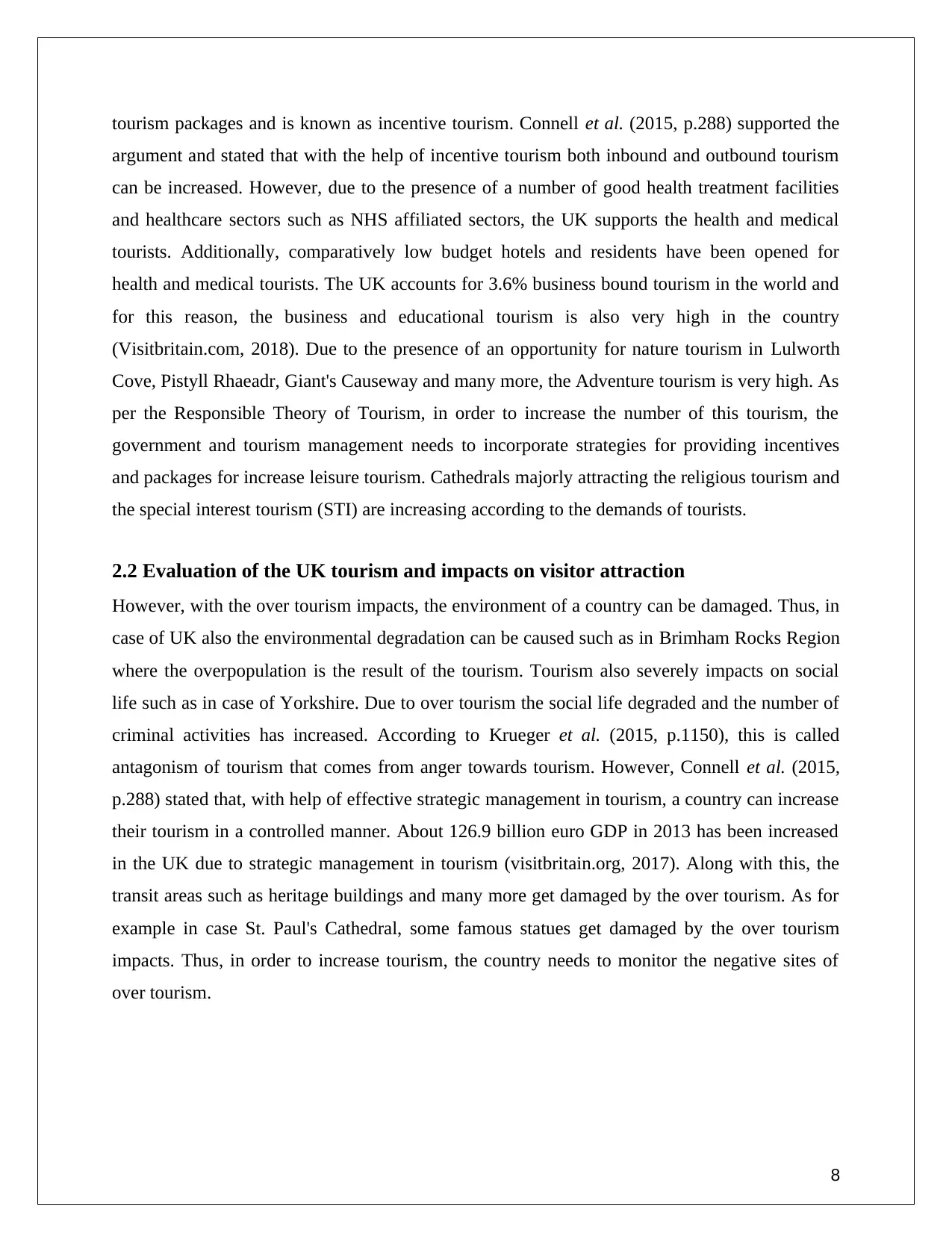
tourism packages and is known as incentive tourism. Connell et al. (2015, p.288) supported the
argument and stated that with the help of incentive tourism both inbound and outbound tourism
can be increased. However, due to the presence of a number of good health treatment facilities
and healthcare sectors such as NHS affiliated sectors, the UK supports the health and medical
tourists. Additionally, comparatively low budget hotels and residents have been opened for
health and medical tourists. The UK accounts for 3.6% business bound tourism in the world and
for this reason, the business and educational tourism is also very high in the country
(Visitbritain.com, 2018). Due to the presence of an opportunity for nature tourism in Lulworth
Cove, Pistyll Rhaeadr, Giant's Causeway and many more, the Adventure tourism is very high. As
per the Responsible Theory of Tourism, in order to increase the number of this tourism, the
government and tourism management needs to incorporate strategies for providing incentives
and packages for increase leisure tourism. Cathedrals majorly attracting the religious tourism and
the special interest tourism (STI) are increasing according to the demands of tourists.
2.2 Evaluation of the UK tourism and impacts on visitor attraction
However, with the over tourism impacts, the environment of a country can be damaged. Thus, in
case of UK also the environmental degradation can be caused such as in Brimham Rocks Region
where the overpopulation is the result of the tourism. Tourism also severely impacts on social
life such as in case of Yorkshire. Due to over tourism the social life degraded and the number of
criminal activities has increased. According to Krueger et al. (2015, p.1150), this is called
antagonism of tourism that comes from anger towards tourism. However, Connell et al. (2015,
p.288) stated that, with help of effective strategic management in tourism, a country can increase
their tourism in a controlled manner. About 126.9 billion euro GDP in 2013 has been increased
in the UK due to strategic management in tourism (visitbritain.org, 2017). Along with this, the
transit areas such as heritage buildings and many more get damaged by the over tourism. As for
example in case St. Paul's Cathedral, some famous statues get damaged by the over tourism
impacts. Thus, in order to increase tourism, the country needs to monitor the negative sites of
over tourism.
8
argument and stated that with the help of incentive tourism both inbound and outbound tourism
can be increased. However, due to the presence of a number of good health treatment facilities
and healthcare sectors such as NHS affiliated sectors, the UK supports the health and medical
tourists. Additionally, comparatively low budget hotels and residents have been opened for
health and medical tourists. The UK accounts for 3.6% business bound tourism in the world and
for this reason, the business and educational tourism is also very high in the country
(Visitbritain.com, 2018). Due to the presence of an opportunity for nature tourism in Lulworth
Cove, Pistyll Rhaeadr, Giant's Causeway and many more, the Adventure tourism is very high. As
per the Responsible Theory of Tourism, in order to increase the number of this tourism, the
government and tourism management needs to incorporate strategies for providing incentives
and packages for increase leisure tourism. Cathedrals majorly attracting the religious tourism and
the special interest tourism (STI) are increasing according to the demands of tourists.
2.2 Evaluation of the UK tourism and impacts on visitor attraction
However, with the over tourism impacts, the environment of a country can be damaged. Thus, in
case of UK also the environmental degradation can be caused such as in Brimham Rocks Region
where the overpopulation is the result of the tourism. Tourism also severely impacts on social
life such as in case of Yorkshire. Due to over tourism the social life degraded and the number of
criminal activities has increased. According to Krueger et al. (2015, p.1150), this is called
antagonism of tourism that comes from anger towards tourism. However, Connell et al. (2015,
p.288) stated that, with help of effective strategic management in tourism, a country can increase
their tourism in a controlled manner. About 126.9 billion euro GDP in 2013 has been increased
in the UK due to strategic management in tourism (visitbritain.org, 2017). Along with this, the
transit areas such as heritage buildings and many more get damaged by the over tourism. As for
example in case St. Paul's Cathedral, some famous statues get damaged by the over tourism
impacts. Thus, in order to increase tourism, the country needs to monitor the negative sites of
over tourism.
8
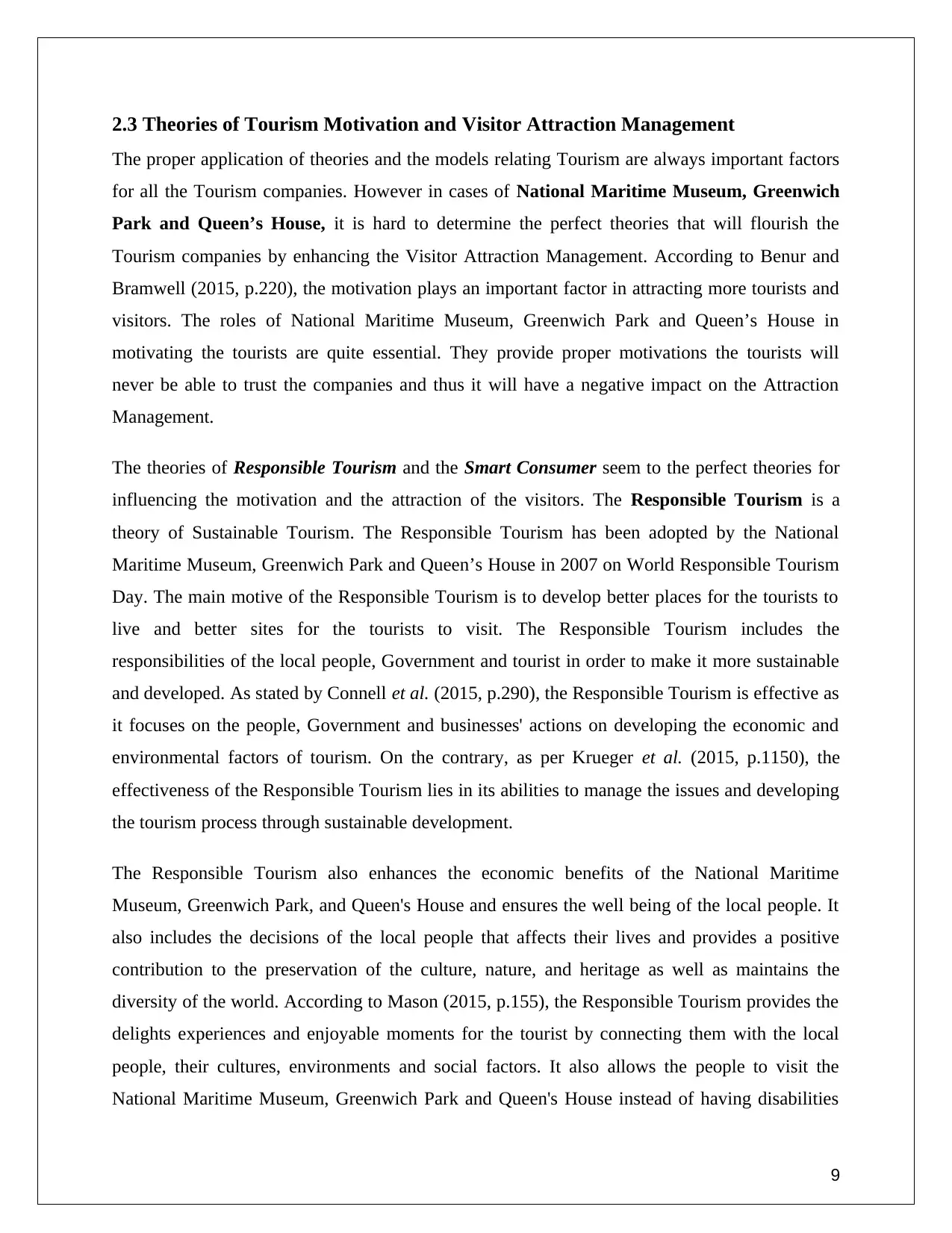
2.3 Theories of Tourism Motivation and Visitor Attraction Management
The proper application of theories and the models relating Tourism are always important factors
for all the Tourism companies. However in cases of National Maritime Museum, Greenwich
Park and Queen’s House, it is hard to determine the perfect theories that will flourish the
Tourism companies by enhancing the Visitor Attraction Management. According to Benur and
Bramwell (2015, p.220), the motivation plays an important factor in attracting more tourists and
visitors. The roles of National Maritime Museum, Greenwich Park and Queen’s House in
motivating the tourists are quite essential. They provide proper motivations the tourists will
never be able to trust the companies and thus it will have a negative impact on the Attraction
Management.
The theories of Responsible Tourism and the Smart Consumer seem to the perfect theories for
influencing the motivation and the attraction of the visitors. The Responsible Tourism is a
theory of Sustainable Tourism. The Responsible Tourism has been adopted by the National
Maritime Museum, Greenwich Park and Queen’s House in 2007 on World Responsible Tourism
Day. The main motive of the Responsible Tourism is to develop better places for the tourists to
live and better sites for the tourists to visit. The Responsible Tourism includes the
responsibilities of the local people, Government and tourist in order to make it more sustainable
and developed. As stated by Connell et al. (2015, p.290), the Responsible Tourism is effective as
it focuses on the people, Government and businesses' actions on developing the economic and
environmental factors of tourism. On the contrary, as per Krueger et al. (2015, p.1150), the
effectiveness of the Responsible Tourism lies in its abilities to manage the issues and developing
the tourism process through sustainable development.
The Responsible Tourism also enhances the economic benefits of the National Maritime
Museum, Greenwich Park, and Queen's House and ensures the well being of the local people. It
also includes the decisions of the local people that affects their lives and provides a positive
contribution to the preservation of the culture, nature, and heritage as well as maintains the
diversity of the world. According to Mason (2015, p.155), the Responsible Tourism provides the
delights experiences and enjoyable moments for the tourist by connecting them with the local
people, their cultures, environments and social factors. It also allows the people to visit the
National Maritime Museum, Greenwich Park and Queen's House instead of having disabilities
9
The proper application of theories and the models relating Tourism are always important factors
for all the Tourism companies. However in cases of National Maritime Museum, Greenwich
Park and Queen’s House, it is hard to determine the perfect theories that will flourish the
Tourism companies by enhancing the Visitor Attraction Management. According to Benur and
Bramwell (2015, p.220), the motivation plays an important factor in attracting more tourists and
visitors. The roles of National Maritime Museum, Greenwich Park and Queen’s House in
motivating the tourists are quite essential. They provide proper motivations the tourists will
never be able to trust the companies and thus it will have a negative impact on the Attraction
Management.
The theories of Responsible Tourism and the Smart Consumer seem to the perfect theories for
influencing the motivation and the attraction of the visitors. The Responsible Tourism is a
theory of Sustainable Tourism. The Responsible Tourism has been adopted by the National
Maritime Museum, Greenwich Park and Queen’s House in 2007 on World Responsible Tourism
Day. The main motive of the Responsible Tourism is to develop better places for the tourists to
live and better sites for the tourists to visit. The Responsible Tourism includes the
responsibilities of the local people, Government and tourist in order to make it more sustainable
and developed. As stated by Connell et al. (2015, p.290), the Responsible Tourism is effective as
it focuses on the people, Government and businesses' actions on developing the economic and
environmental factors of tourism. On the contrary, as per Krueger et al. (2015, p.1150), the
effectiveness of the Responsible Tourism lies in its abilities to manage the issues and developing
the tourism process through sustainable development.
The Responsible Tourism also enhances the economic benefits of the National Maritime
Museum, Greenwich Park, and Queen's House and ensures the well being of the local people. It
also includes the decisions of the local people that affects their lives and provides a positive
contribution to the preservation of the culture, nature, and heritage as well as maintains the
diversity of the world. According to Mason (2015, p.155), the Responsible Tourism provides the
delights experiences and enjoyable moments for the tourist by connecting them with the local
people, their cultures, environments and social factors. It also allows the people to visit the
National Maritime Museum, Greenwich Park and Queen's House instead of having disabilities
9
⊘ This is a preview!⊘
Do you want full access?
Subscribe today to unlock all pages.

Trusted by 1+ million students worldwide
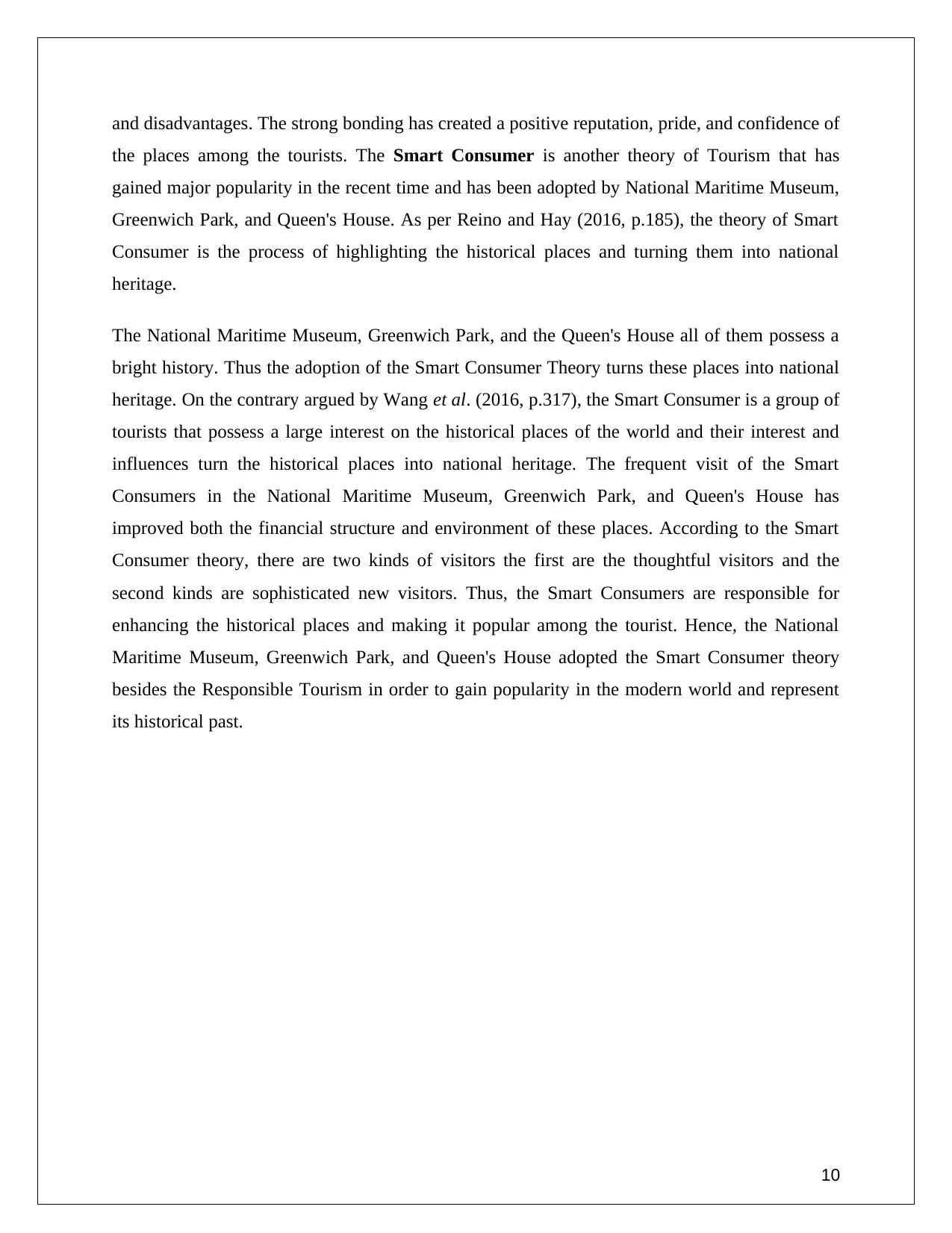
and disadvantages. The strong bonding has created a positive reputation, pride, and confidence of
the places among the tourists. The Smart Consumer is another theory of Tourism that has
gained major popularity in the recent time and has been adopted by National Maritime Museum,
Greenwich Park, and Queen's House. As per Reino and Hay (2016, p.185), the theory of Smart
Consumer is the process of highlighting the historical places and turning them into national
heritage.
The National Maritime Museum, Greenwich Park, and the Queen's House all of them possess a
bright history. Thus the adoption of the Smart Consumer Theory turns these places into national
heritage. On the contrary argued by Wang et al. (2016, p.317), the Smart Consumer is a group of
tourists that possess a large interest on the historical places of the world and their interest and
influences turn the historical places into national heritage. The frequent visit of the Smart
Consumers in the National Maritime Museum, Greenwich Park, and Queen's House has
improved both the financial structure and environment of these places. According to the Smart
Consumer theory, there are two kinds of visitors the first are the thoughtful visitors and the
second kinds are sophisticated new visitors. Thus, the Smart Consumers are responsible for
enhancing the historical places and making it popular among the tourist. Hence, the National
Maritime Museum, Greenwich Park, and Queen's House adopted the Smart Consumer theory
besides the Responsible Tourism in order to gain popularity in the modern world and represent
its historical past.
10
the places among the tourists. The Smart Consumer is another theory of Tourism that has
gained major popularity in the recent time and has been adopted by National Maritime Museum,
Greenwich Park, and Queen's House. As per Reino and Hay (2016, p.185), the theory of Smart
Consumer is the process of highlighting the historical places and turning them into national
heritage.
The National Maritime Museum, Greenwich Park, and the Queen's House all of them possess a
bright history. Thus the adoption of the Smart Consumer Theory turns these places into national
heritage. On the contrary argued by Wang et al. (2016, p.317), the Smart Consumer is a group of
tourists that possess a large interest on the historical places of the world and their interest and
influences turn the historical places into national heritage. The frequent visit of the Smart
Consumers in the National Maritime Museum, Greenwich Park, and Queen's House has
improved both the financial structure and environment of these places. According to the Smart
Consumer theory, there are two kinds of visitors the first are the thoughtful visitors and the
second kinds are sophisticated new visitors. Thus, the Smart Consumers are responsible for
enhancing the historical places and making it popular among the tourist. Hence, the National
Maritime Museum, Greenwich Park, and Queen's House adopted the Smart Consumer theory
besides the Responsible Tourism in order to gain popularity in the modern world and represent
its historical past.
10
Paraphrase This Document
Need a fresh take? Get an instant paraphrase of this document with our AI Paraphraser
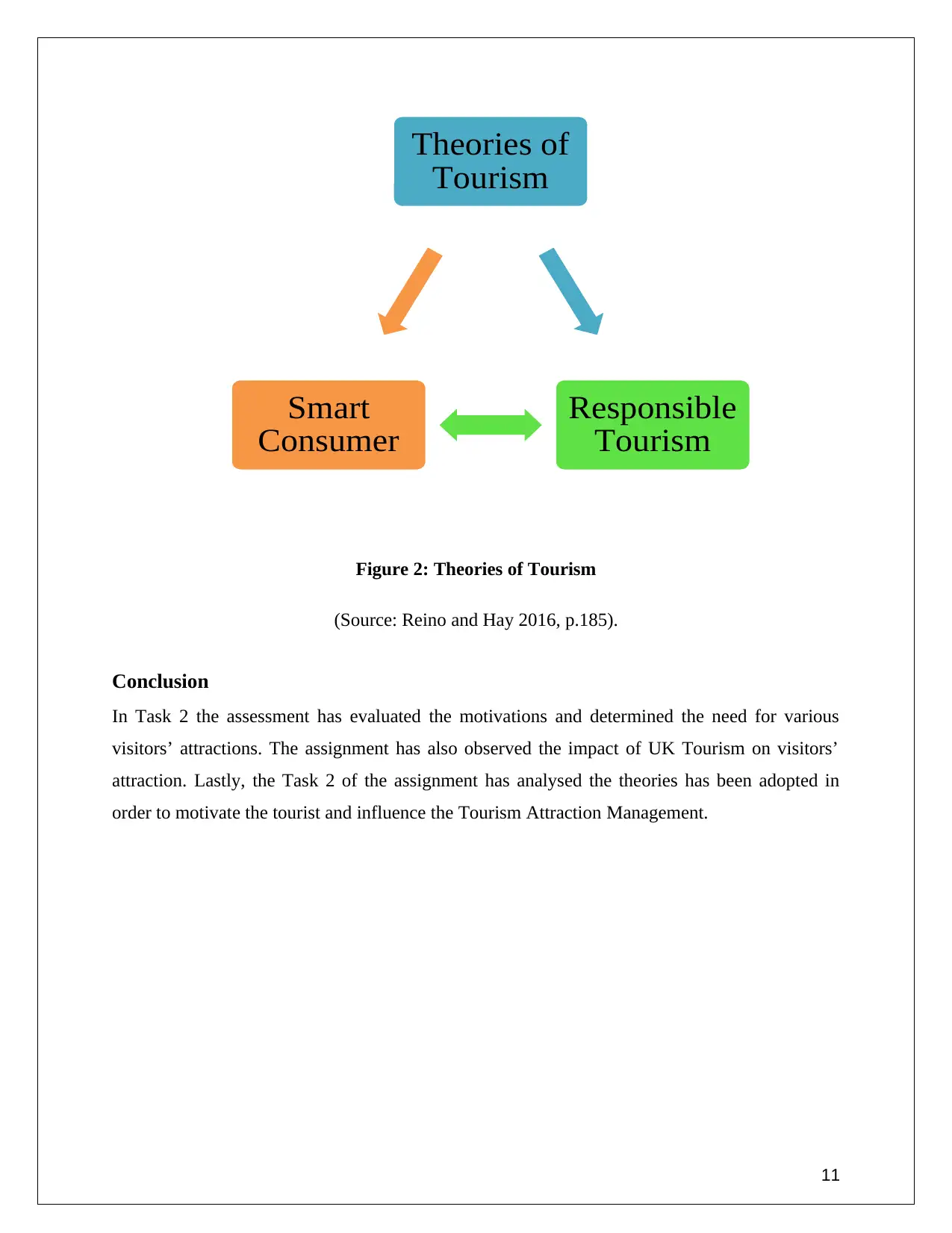
Figure 2: Theories of Tourism
(Source: Reino and Hay 2016, p.185).
Conclusion
In Task 2 the assessment has evaluated the motivations and determined the need for various
visitors’ attractions. The assignment has also observed the impact of UK Tourism on visitors’
attraction. Lastly, the Task 2 of the assignment has analysed the theories has been adopted in
order to motivate the tourist and influence the Tourism Attraction Management.
11
Theories of
Tourism
Responsible
Tourism
Smart
Consumer
(Source: Reino and Hay 2016, p.185).
Conclusion
In Task 2 the assessment has evaluated the motivations and determined the need for various
visitors’ attractions. The assignment has also observed the impact of UK Tourism on visitors’
attraction. Lastly, the Task 2 of the assignment has analysed the theories has been adopted in
order to motivate the tourist and influence the Tourism Attraction Management.
11
Theories of
Tourism
Responsible
Tourism
Smart
Consumer
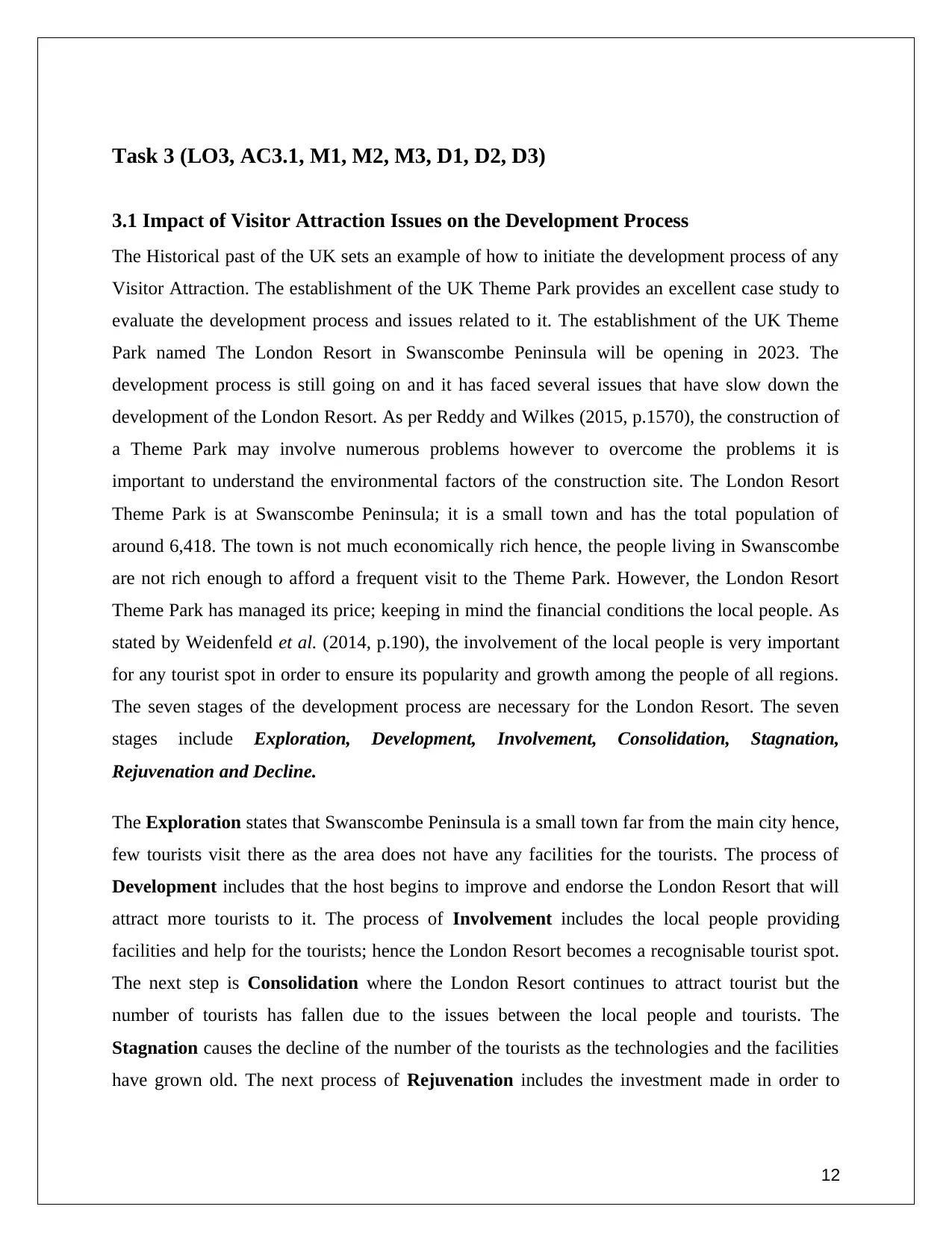
Task 3 (LO3, AC3.1, M1, M2, M3, D1, D2, D3)
3.1 Impact of Visitor Attraction Issues on the Development Process
The Historical past of the UK sets an example of how to initiate the development process of any
Visitor Attraction. The establishment of the UK Theme Park provides an excellent case study to
evaluate the development process and issues related to it. The establishment of the UK Theme
Park named The London Resort in Swanscombe Peninsula will be opening in 2023. The
development process is still going on and it has faced several issues that have slow down the
development of the London Resort. As per Reddy and Wilkes (2015, p.1570), the construction of
a Theme Park may involve numerous problems however to overcome the problems it is
important to understand the environmental factors of the construction site. The London Resort
Theme Park is at Swanscombe Peninsula; it is a small town and has the total population of
around 6,418. The town is not much economically rich hence, the people living in Swanscombe
are not rich enough to afford a frequent visit to the Theme Park. However, the London Resort
Theme Park has managed its price; keeping in mind the financial conditions the local people. As
stated by Weidenfeld et al. (2014, p.190), the involvement of the local people is very important
for any tourist spot in order to ensure its popularity and growth among the people of all regions.
The seven stages of the development process are necessary for the London Resort. The seven
stages include Exploration, Development, Involvement, Consolidation, Stagnation,
Rejuvenation and Decline.
The Exploration states that Swanscombe Peninsula is a small town far from the main city hence,
few tourists visit there as the area does not have any facilities for the tourists. The process of
Development includes that the host begins to improve and endorse the London Resort that will
attract more tourists to it. The process of Involvement includes the local people providing
facilities and help for the tourists; hence the London Resort becomes a recognisable tourist spot.
The next step is Consolidation where the London Resort continues to attract tourist but the
number of tourists has fallen due to the issues between the local people and tourists. The
Stagnation causes the decline of the number of the tourists as the technologies and the facilities
have grown old. The next process of Rejuvenation includes the investment made in order to
12
3.1 Impact of Visitor Attraction Issues on the Development Process
The Historical past of the UK sets an example of how to initiate the development process of any
Visitor Attraction. The establishment of the UK Theme Park provides an excellent case study to
evaluate the development process and issues related to it. The establishment of the UK Theme
Park named The London Resort in Swanscombe Peninsula will be opening in 2023. The
development process is still going on and it has faced several issues that have slow down the
development of the London Resort. As per Reddy and Wilkes (2015, p.1570), the construction of
a Theme Park may involve numerous problems however to overcome the problems it is
important to understand the environmental factors of the construction site. The London Resort
Theme Park is at Swanscombe Peninsula; it is a small town and has the total population of
around 6,418. The town is not much economically rich hence, the people living in Swanscombe
are not rich enough to afford a frequent visit to the Theme Park. However, the London Resort
Theme Park has managed its price; keeping in mind the financial conditions the local people. As
stated by Weidenfeld et al. (2014, p.190), the involvement of the local people is very important
for any tourist spot in order to ensure its popularity and growth among the people of all regions.
The seven stages of the development process are necessary for the London Resort. The seven
stages include Exploration, Development, Involvement, Consolidation, Stagnation,
Rejuvenation and Decline.
The Exploration states that Swanscombe Peninsula is a small town far from the main city hence,
few tourists visit there as the area does not have any facilities for the tourists. The process of
Development includes that the host begins to improve and endorse the London Resort that will
attract more tourists to it. The process of Involvement includes the local people providing
facilities and help for the tourists; hence the London Resort becomes a recognisable tourist spot.
The next step is Consolidation where the London Resort continues to attract tourist but the
number of tourists has fallen due to the issues between the local people and tourists. The
Stagnation causes the decline of the number of the tourists as the technologies and the facilities
have grown old. The next process of Rejuvenation includes the investment made in order to
12
⊘ This is a preview!⊘
Do you want full access?
Subscribe today to unlock all pages.

Trusted by 1+ million students worldwide
1 out of 26
Related Documents
Your All-in-One AI-Powered Toolkit for Academic Success.
+13062052269
info@desklib.com
Available 24*7 on WhatsApp / Email
![[object Object]](/_next/static/media/star-bottom.7253800d.svg)
Unlock your academic potential
Copyright © 2020–2025 A2Z Services. All Rights Reserved. Developed and managed by ZUCOL.

